
Für eine deutsche Übersetzung dieser Seite einfach die Brandenburger Flagge anklicken
 |
Click the Brandenburg Flag for a German translation Für eine deutsche Übersetzung dieser Seite einfach die Brandenburger Flagge anklicken |


 |
Home TownsThe Early History of Mendocino County |
 |

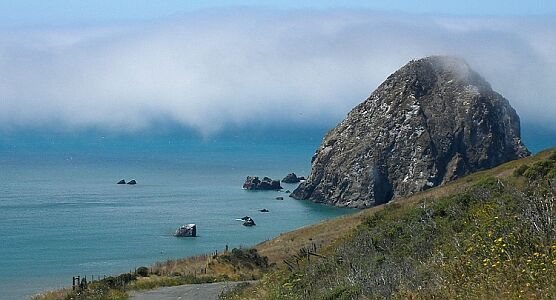 Cape Mendocino
Cape Mendocino
|
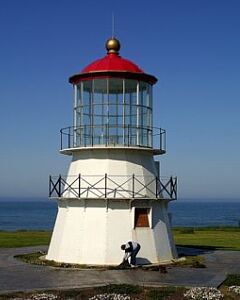 Cape Mendocino Lighthouse
Cape Mendocino Lighthouse
|


|
36.5 million people live in California. 30.5 million of them live in only four large population centers: the Greater Los Angeles area, the San Francisco Bay Area, the Central Valley, and San Diego. That leaves only a hand full of people for the rest, and only 2% of California's population (or 87,000 people) live in Mendocino County. Fort Bragg, where Judy spent a number of years, only has 7,000 inhabitants, but for Northern California, that is a big city – the largest settlement along the coast between San Francisco and Eureka. Until 2004, fort Bragg was the proud owner of the only traffic light on Highway One north of the Golden Gate Bridge.
If you want to see what Fort Bragg, Caspar and other places in Mendocino County look like today, But if you are interested in the history of this area, stay here. |
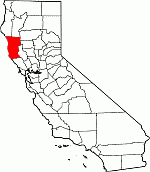
|

|
For more than 8,000 years, three Native American nations, the Yuki,
the Pomo, and the Wintun
lived peacefully and undisturbed in this area. They all were decedents of the Hokan
who came here in about 7,000 BC (that is four and a half millennia before the Great Pyramids in Egypt were built).
The American Northwest was one of the last regions to be explored by Europeans and it wasn't until three centuries after Columbus' landing,
that the people here were exposed to the "Gifts of Civilization." |
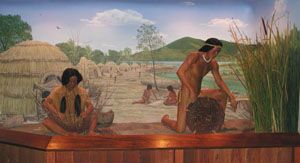
|

The first European to see this rugged coast was the Portuguese explorer
Juan Rodriguez Cabrillo. Cabrillo, who had started life as a shipbuilder's boy built his own ship and offered
his services to the Spanish in Mexico.
 In 1542, he set sail from Acapulco and became the first European to sail along the California coast. He never landed anywhere north of San Diego, but he sailed as far enough to find the westernmost point of the California coast.  He named that point Cape Mendocino, in honor of Antonio de Mendoza, Viceroy of New Spain.  XXXXXXXXXXXXXXXXXCabrillo on board his flagship, the "San Salvador" |
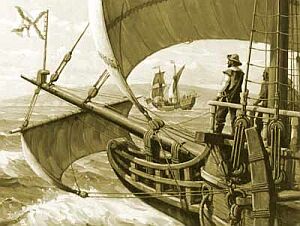
|

The first white man to actually set foot in this area was most likely the British captain
George Vancouver, who came to Trinidad Bay
(a little bit further up north) in 1793 and is suspected to have left the first gift of the White Men:
a cholera epidemic. Many other "gifts", like the small pocks epidemic of 1837, followed.
 Vancouver claimed the land for Britain (As did Francis Drake almost 200 years before when he landed near what is now San Francisco), but the British never enforced their claim and Spanish influence as well never expanded much beyond San Francisco. And so, nothing changed for another generation.  XXXXXXXXXXXXXXXXXXXXXCaptain Vancouver's ship, the "Discovery" |
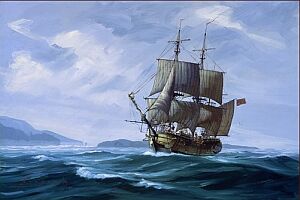
|

The North remained one of the last "undiscovered" areas far into the 19th century.
The only European country to establish a real presence in the area was – Russia! Between 1799 and 1820, the
Russian-American Company established a colonial
empire with forts in Hawaii and Alaska and in 1812, the Russians reached the southernmost point of their expansion
and built Форт Росс just north of San Francisco.
 At this time the main business for white men in the area was fur trade, dominated by the Russians and by the British Hudson Bay Company. But in the 1820, the fur trade declined and the area was quiet again for another 20 years.  XXXXXXXXXXXXXXXXXXXXXXXRussian Fort Ross in Sonoma County |
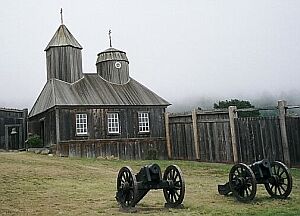
|

Everything changed with the Gold Rush.
There was no gold in this area, but the national treasure of Northern California, the Redwood forests,
fell victim to the rush of thousands of people coming to California. In 1948, San Francisco was a tiny
village with about 1,000 inhabitants – two years later it was a thriving city with 25,000 people. And
all the new houses were built using Redwood from the north. The first
sawmills in Mendocino County were built in 1852, and by 1880, there were thirty of them and it is save to assume
that the saw mill owners earned a lot more gold than the diggers in the fields along the Sacramento River.
 XXXXXXXAn entire lumber camp poses with a 26 ft diameter Redwood tree, 1898. |
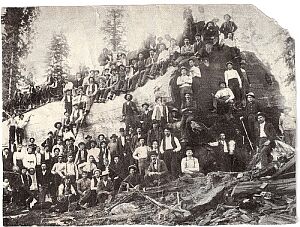
|



Amongst other hardships, the relocation created California's very own Trail
of Tears, when a number of tribes in the Sacramento Valley were marched to a reservation near Round Valley.
One of the tribes, the Nome Lacka
lost half of its members during the relocation. The relocations and a lot of local conflicts led to the
Mendocino War of 1859/60. Later, a governmental
report stated, that "in four months in 1860; more Indians of Mendocino County had been killed than in a century of Spanish and Mexican rule."
 After that, the California North was changed forever and, unfortunately, most memories of these "prehistoric" times have been lost. Our history books tell us about the great battles of the Lakota and Apache in the central plains, but the silent destruction of the California Indians has been all but forgotten.  For more about the destruction of the California Indians, we recommend the book When The Great Spirit Died. |
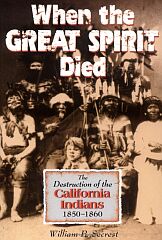
|


| If you came here from one of our "Hometown" sites, click the town's seal or name to get back. |

 |
Fort Bragg |
 |
Caspar |


 Back to Home Towns |
 Back to California Page |
 Back to English Main Page |
 Back to Start Page |